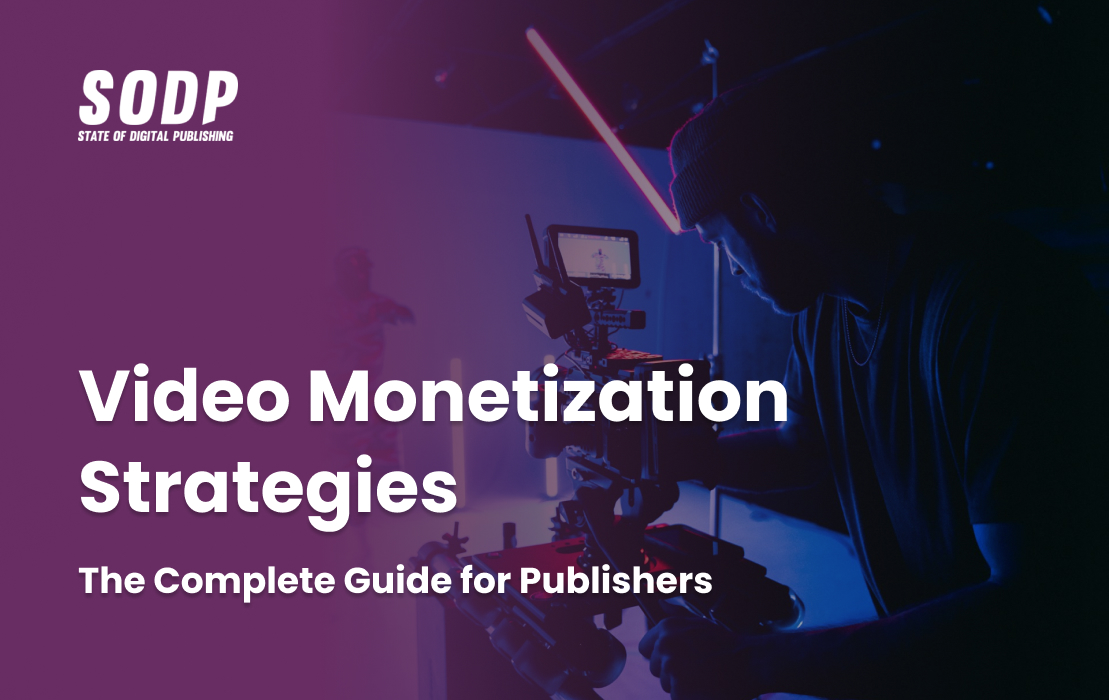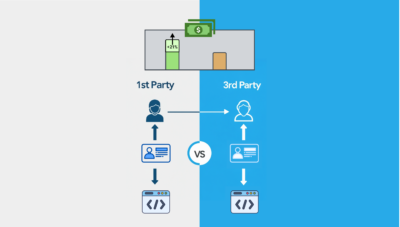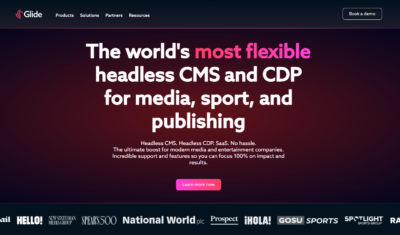Video is one of the most preferred means of storytelling, education and entertainment for content consumers across the board.
Individuals now spend 17 hours per week on average consuming video content (PDF download). Furthermore, people are more likely to share video content — be it with friends, colleagues or social media followers — over any other type.
For publishers, this presents an unparalleled opportunity. Video content is not just a medium for storytelling; it’s a goldmine for generating revenue, whether through ad revenue sharing, tiered subscriptions or innovative video monetization models such as in-video shopping.
Join us as we examine the various video monetization strategies publishers can use to capitalize on this booming market.
What Is Video Monetization?
Video monetization is how publishers generate revenue from their video content. It involves leveraging various strategies and platforms to convert video views into a revenue stream.
This could mean anything from embedding ads within the video to offering premium content via a subscription model. The objective is simple: monetize content effectively while delivering value to the audience.
Notably, there are different video monetization models tailored to meet the unique needs of publishers.
For example, live streaming can be monetized through real-time ads or exclusive access fees. Video on demand (VOD) allows for tiered subscriptions where viewers pay for the content they wish to see. Then there’s the affiliate marketing model, where publishers earn commissions by promoting products or services within their videos.
Each model offers a distinct approach to monetizing content, allowing publishers to choose a strategy that aligns with their goals and audience preferences.
How to Monetize Video Content
As mentioned briefly earlier, there are several ways in which publishers can monetize their videos. Let’s take a closer look at the most popular.
1. Ad Revenue Sharing
Ad revenue sharing is a popular video monetization strategy where publishers partner with a video monetization platform such as YouTube, Vimeo or specialized ad networks to display ads within their video content.
The screenshot below is an example of the ad revenue from a YouTube video.

Source: Ali Abdal
This strategy is particularly beneficial for publishers who have a large number of videos and a substantial viewer base. Once the ads are set up, publishers passively earn a share of the revenue generated from viewer interactions with the ads — be it clicks or impressions.
Some best practices for this method include:
- Targeted advertising: Leverage platform analytics to understand the audience and tailor ads that are relevant to them.
- Ad placement: Be strategic about ad placement within the video. For example, one study found that mid-roll ads have a better chance of being completed than pre-roll ads.
- Quality over quantity: While it may be tempting to flood videos with ads, this can deter viewers. Striking a balance between monetizing content and maintaining viewer satisfaction is crucial.
2. Tiered Subscriptions
Tiered subscriptions are a monetization model where viewers pay higher or lower recurring fees to access different content levels. Netflix is a prime example of this strategy, offering various subscription plans based on the number of screens and video quality.

Source: Netflix
Publishers should consider this strategy when they have a diverse range of video content that can be categorized into different value propositions.
For example, a basic subscription could offer standard video quality and limited access to archives, while a premium subscription could offer high-definition video and exclusive content.
Unlike ad-based models, tiered subscriptions provide a more predictable and consistent revenue stream. Additionally, offering varied tiers can encourage longer-term commitments, foster customer loyalty and reduce churn rates.
Publishers should keep these best practices while generating revenue with this paywall strategy for the best results:
- Value proposition: Clearly define each tier’s offer and ensure the value aligns with the cost. This will help attract and retain a wide range of subscribers.
- Flexible plans: Offer flexibility in subscription plans, such as monthly, quarterly or annual options, to cater to different customer preferences.
- Exclusive content: Use premium content as a hook to entice viewers into opting for higher-tier subscriptions. This could be anything from exclusive interviews to early access to new releases.
- Regular updates: Keep the content fresh and regularly updated to maintain subscriber interest. Stale or outdated content can lead to increased churn rates.
3. Sponsored Content
Sponsored content is a video monetization strategy where publishers collaborate with brands or companies to create and promote content that subtly integrates the sponsor’s message or product.
Unlike traditional ads, sponsored content is often more seamlessly woven into the video, providing a less intrusive viewer experience. Various independent content creators often leverage this strategy to produce videos profitably.

Source: YouTube
This strategy is ideal for publishers who have built a strong, engaged audience and have a voice or theme that aligns well with specific brands. It’s particularly effective for niche markets where the publisher’s content and the sponsor’s product or message have a natural synergy.
Publishers can earn more revenue from sponsored content than traditional advertising models given the higher editorial input required. Of course, the flipside is the amount of time the publisher invests in the creation process.
However, because the content is integrated into the publisher’s regular offerings, it’s usually better received by the audience, maintaining trust and engagement levels. Also, sponsored content isn’t at risk of being intercepted by adblockers in the way traditional ads are.
While employing this video content monetization method, publishers should consider the following:
- Audience alignment: Choose sponsors whose products or messages align well with the publisher’s audience. A mismatch can lead to viewer disengagement.
- Transparency: Always disclose that the content is sponsored to maintain audience trust. Transparency is vital to ethical video content monetization.
- Quality over quantity: Focus on creating high-quality, engaging content rather than pushing the sponsor’s message too aggressively. The sponsorship should feel like a natural part of the content.
4. Peer-to-Peer (P2P) Video Networking
Peer-to-peer (P2P) video networking is a relatively new but promising video monetization strategy where each participant (peer) can act as a server and a client. Let’s consider the example of two people who want to watch the same video.
In a traditional setup, they must connect to a centralized server to stream the content. As more people join in, the server must handle that increased load to meet client demands.
However, with P2P video networking, the device of the first client can act as a server for the second client, making the entire video streaming process economical and efficient.
Humix, a leading P2P video networking platform, allows publishers to generate ad revenue by serving videos from their original site or channel on multiple platforms. All publishers need to do is publish their content on Humix and it will be accessible to their audience on other popular sites of choice.
At the same time, they can also insert similar videos from other publishers on their native platform or website, increasing engagement.

Source: Humix
This strategy particularly benefits publishers looking to expand their reach beyond their platforms. It’s an excellent option for those who have high-quality video content that is relevant to a broader audience.
Furthermore, publishers can generate revenue not just from their content but also from displaying other publishers’ videos on their platforms while leveraging the network community, leading to enhanced brand recognition and audience loyalty.
While monetizing videos on a P2P network, publishers need to be aware of:
- Quality control: Ensure that the videos being displayed, whether they are on a self-owned or a partner network, meet the quality standards that the audience expects.
- Transparency and trust: Indicate which content is coming from the P2P network and which is original. Transparency is crucial for maintaining audience trust.
- Performance tracking: This will help in optimizing the monetization methods being employed and, hence, maximizing revenue.
5. Pay-Per-View (PPV)
The pay-per-view (PPV) monetization model gives viewers access to specific content for a limited period by charging a one-time fee. A classic example of this strategy is the Ultimate Fighting Championship (UFC), where fans pay to watch individual fights or events.

Source: UFC
This strategy is best suited for publishers who offer high-value, exclusive content that has a strong demand. It’s particularly effective for live-streaming special events, exclusive interviews or premium educational content.
PPV generates immediate revenue upon purchase, making it a lucrative option for one-off events or exclusive releases. Additionally, unlike subscription models, PPV doesn’t require a long-term commitment from viewers, making it easier to attract a broader audience.
To capitalize on this method well, publishers should consider:
- Pricing strategy: Carefully consider content pricing. Prices should reflect the content’s value but also be accessible enough to attract a large number of viewers.
- Promotion: Leverage social media, email marketing and other channels to create buzz before the release date. The more anticipation is built, the higher the potential revenue.
- User experience: Ensure a seamless payment and viewing experience. Any hiccups in the process could deter potential viewers and affect revenue.
- Post-event engagement: After the event or release, engage with the audience through follow-up content or surveys. This not only enhances viewer experience but also provides valuable insights for future pay-per-view events.
6. Donations and Crowdfunding
Donations and crowdfunding are video monetization methods where publishers solicit financial support directly from their audience. A notable example is the UK daily The Guardian, which asks its audience to support its journalism through voluntary contributions.

Source: YouTube
This strategy is particularly effective for publishers with a strong, engaged community around their content. It’s ideal for those who produce content that has social, cultural or educational value and wish to keep it accessible to everyone.
Donations and crowdfunding can provide a sustainable revenue stream that is less dependent on advertising or subscription fees to give publishers greater creative freedom where they can focus on producing high-quality, impactful content.
Publishers need to keep these tips in mind while relying on donations:
- Transparency: Be open about how the funds will be used. Transparency builds trust and encourages more people to contribute.
- Incentives: Offer special perks or exclusive content to donors as a token of appreciation. This not only incentivizes donations but also enhances the value proposition.
- Regular updates: Keep the community informed about milestones reached, upcoming projects and how their contributions are making a difference.
- Easy donation process: Make the donation process as simple and frictionless as possible. A complicated or cumbersome process can deter potential donors.
7. Third-Party Licensing
Third-party licensing involves granting other platforms or entities the rights to distribute a publisher’s video content. In return, the publisher receives a licensing fee or a share of the revenue generated from their content on the third-party platform.
This strategy is well-suited for publishers who have a library of high-quality, evergreen content that has the potential for broader distribution.
It’s especially effective for content that has already enjoyed a successful run on the publisher’s channels and can now be monetized further through external channels.
One of the main advantages of licensing content to third parties is that it opens up a new avenue for revenue generation without additional production costs. Additionally, the content gains exposure to a new audience, potentially driving traffic back to the publisher’s platform.
Here are a few precautionary steps publishers should take while implementing this strategy:
- Due diligence: Conduct thorough research on potential licensing partners to ensure they are reputable and their audience aligns with content.
- Clear terms: Clearly outline the terms of the licensing agreement, including revenue-sharing models, content usage restrictions and license duration.
- Quality assurance: Ensure the third-party platform maintains the content’s quality and integrity. This includes proper presentation and the absence of unauthorized edits or alterations.
8. Affiliate Marketing
Affiliate marketing allows publishers and creators to monetize their video content by promoting products or services and earning commissions from each sale made for their partner.
This strategy is often used in product reviews, tutorials and other content where a product or service can be naturally integrated.

Source: YouTube
Publishers should consider this strategy when they have a strong, engaged audience that trusts their recommendations. It’s particularly effective for niche content where specific products or services can be organically introduced.
Unlike other monetization methods, affiliate marketing is performance-based, meaning publishers earn revenue directly correlated to the actions taken by viewers. The best part is that there’s minimal risk involved, as publishers don’t need to invest in product creation or inventory.
Here are a few tips that can come in handy while leveraging affiliate marketing to monetize videos:
- Audience relevance: Choose products or services that are highly relevant to the audience. Irrelevant recommendations can erode trust.
- Transparency: Clearly disclose affiliate relationships to maintain audience trust. A simple disclaimer at the beginning or end of the video is sufficient.
- Quality over quantity: Focus on promoting a few high-quality products rather than many items. This enhances credibility and increases the likelihood of conversions.
- Track and optimize: Use analytics to track the performance of affiliate links. Monitor click-through rates (CTRs), conversions and revenue to continually optimize the strategy.
9. In-Video Shopping
In-video shopping, as the name suggests, allows publishers to give their audience the freedom to buy products or book services while watching a video.
A prime example of this is Bambuser, a platform that specializes in making videos shoppable on a publisher’s site.

Source: Bambuser
Publishers should consider this strategy when they have a catalog of products that can be seamlessly integrated into video content. It’s particularly effective for lifestyle, fashion and tech reviews where products can be naturally showcased.
This model allows for immediate conversion, as viewers can purchase without leaving the video, reducing drop-off rates. As it offers a one-stop-shop experience, from viewing to purchasing, in-video shopping enhances user engagement and satisfaction, ultimately helping conversions.
For instance, Samsung used Bambuser to exceed their conversion goals during product launches by an impressive 127%.
Publishers need to be mindful of the following:
- Seamless integration: Ensure the shopping feature is intuitively designed and does not disrupt the video viewing experience.
- Product relevance: Only feature products directly relevant to the video content to maintain viewer interest and trust.
- Clear call-to-action (CTA): Use clear and compelling calls to action to guide the viewer toward purchasing.
Final Thoughts
Whether for education, information or entertainment purposes, people tend to gravitate toward video as their preferred form of content. As such, publishers that develop a comprehensive monetization and pair it with one of the best video monetization platforms will be well placed to capitalize on this opportunity.
After reviewing the above nine strategies, the key takeaway is that there isn’t a one-size-fits-all solution. Publishers need to dive deeper and learn about their audience’s preferences regularly to consistently produce engaging content profitably.
For instance, if a publisher covers lifestyle products extensively, in-video shopping is a great solution, but for educational content creators, offering tiered subscriptions is likely a better fit.
Furthermore, relying on a single monetization method is risky. A diversified approach, which incorporates multiple video monetization models, can offer a more stable revenue stream.
The future of video is incredibly promising, with ample opportunities for publishers to generate revenue in creative ways. By staying informed and adaptable, publishers can not only better monetize video content but also continue enriching the viewer experience.






